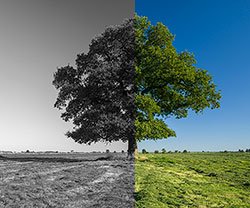How real are colors: From the stimulus to the subjective sensation - Part 3

Are colors real or just a deception of our brain? © agsandrew/ thinkstockIs a tree really green - even if nobody sees it? And when we see colors, do we share this experience with others, or does each individual perceive something different? Mankind has been preoccupied with these questions for thousands of years - and science has given and gives different answers to them.
This is the third part of this article series. If you have missed any previous parts, don't forget to catch up on it:
- How real are colors: All illusion? - Part 1
- How real are colors: From the waves to the stimulus - Part 2
Part 3: From the stimulus to the subjective sensation. What does neurobiology say?
Now the scientist himself can not care whether the tree is green or not apart from its material particle structure and its reflection properties. The question no longer appears in his measurements and theories. The denial of the qualities therefore does not result from a physical necessity - and is usually not even represented by physicists.
From the nerve signal to perception

Neuronal processes in the brain - more precisely in the visual cortex - are the prerequisite for our impression of colour. © public domainRather, it is based on a scientist view of the world, which declares the parts of the world originally chosen for the purpose of measurability and predictability and the constructs derived from them (particles, forces, fields, etc.) as "real" reality. Then the green tree would only be a large molecular cluster, the song of the nightingale in its branches would be an irregular sequence of air pressure fluctuations and the joy of the wanderer listening to it would be a certain neuronal excitation pattern.
That brings us to neurobiology: It should trace the subjective qualities eliminated from nature back to neuronal activities: Colours become subjective sensations or illusions created by the brain. Although the involved neuronal pathways and areas are largely known today, the neurobiologist also fails to reduce the reduction of colours to material processes.
The black and white Mary
This is shown by a thought experiment by the fictional, ingenious neuroscientist Mary, described by Frank Jackson, who researched and appropriated everything that is conceivable about the physics and physiology of color perception. Unfortunately, Mary lived in a black and white laboratory from birth and therefore never saw colours herself. But one day she is freed from her prison and sees green trees for the first time in her life.

How does Mary see this tree? Does it seem as green as to us? And what does "green" mean to her? © Axel Ellerhorst / iStockIs she now experiencing something new? Certainly, we would say, because what it is really like to see green, yellow or blue differs fundamentally from all her knowledge about electromagnetic waves and the action potentials of nerve cells. Neuroscientists too, can therefore only detect certain brain processes as necessary conditions for the vision of the green tree.
This can explain the colour blindness, i. e. the loss of colour perception due to brain lesions. But all knowledge of these processes can neither anticipate nor adequately explain Mary's own green perception. In other words, there is a fundamental gap between the subjective experience of the world and its materialistic description.
Source: Prof. Dr. Dr. Thomas Fuchs, Universität Heidelberg: Ist der Baum Grün?

This is definitely a really interesting topic to talk about and I love the way you're covering it. I remember a question I used to ask myself everyday, when I needed a good mind confusion, sometimes I still ask myself this: how do other percieve colors? Do they see blue, the way I see blue? It really makes you think, because there's no possible way to make sure. haha!
Hey @benjaminstrusnik, yes indeed it's a very interesting topic. I am glad you like the way I am writing about it and the question about wether others perceive color the same as you do can be a mind boggling task :-) . I had conversations about this topic with my brother when I was much younger.
From a subjective point of view it's more likely to say, that we all perceive colors in a personal / different way.
You should definitely stay tuned for the next two parts. Those will cover some more insights.
Interesting article, the eyes only see black and white, in reality the color does not exist, everything is degradation of the balco and black. congratulations I loved the post.
Thank you! I am glad you like my article!
This post has received a 1.53 % upvote from @booster thanks to: @n3bul4.
Following you!